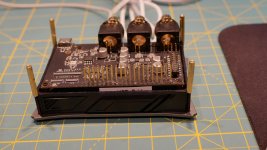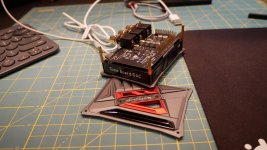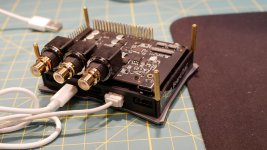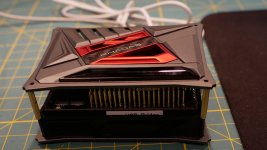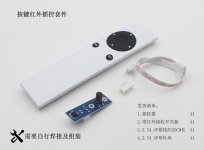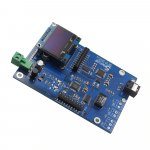Help with DAC choice
Hello all.
I am searching for a little help/advice. I am quite good in analog electronics, but digital world is a bit new for me.
I am planning an active 3-way system with a USB streamer > DSP > DAC. Preliminary plan is to use Amanero and miniDSP miniSHARC, in fact I have the miniSHARC already as well as regulated +-15V and +5 to 8 V power supplies.
I look for 3x reasonably good and priceworthy DACs which require no or minimum modifications. I have been looking at these V1.07 ES9038 Chinese boards, but after reading through this thread I get an impression it does not sound very good as is and require quite many mods. I wonder if there any good DAC boards that are somewhat more expensive, but need no mods?
Would the following DAC be a good option?
Lusya AK4495S AK4495SEQ I2S DAC Audio decoder board support 32BIT 768K decoder T0241-in Digital-to-Analog Converter from Consumer Electronics on Aliexpress.com | Alibaba Group
I also realized it is not only the chip itself that influence the final sound, but the implementation and mainly the power supply. In my case if I get 3 DACs and each of them probably 2 or 3 different power sources. So, the question is also if I can use each power source for all 3 DACs or should it be each of individual ones for each DAC?
Another question, I found the following board also available for miniSHARC would it be a good idea to use it in my project:
Single MiniSHARC link board
– waveflex
Any help much appreciated.
Hello all.
I am searching for a little help/advice. I am quite good in analog electronics, but digital world is a bit new for me.
I am planning an active 3-way system with a USB streamer > DSP > DAC. Preliminary plan is to use Amanero and miniDSP miniSHARC, in fact I have the miniSHARC already as well as regulated +-15V and +5 to 8 V power supplies.
I look for 3x reasonably good and priceworthy DACs which require no or minimum modifications. I have been looking at these V1.07 ES9038 Chinese boards, but after reading through this thread I get an impression it does not sound very good as is and require quite many mods. I wonder if there any good DAC boards that are somewhat more expensive, but need no mods?
Would the following DAC be a good option?
Lusya AK4495S AK4495SEQ I2S DAC Audio decoder board support 32BIT 768K decoder T0241-in Digital-to-Analog Converter from Consumer Electronics on Aliexpress.com | Alibaba Group
I also realized it is not only the chip itself that influence the final sound, but the implementation and mainly the power supply. In my case if I get 3 DACs and each of them probably 2 or 3 different power sources. So, the question is also if I can use each power source for all 3 DACs or should it be each of individual ones for each DAC?
Another question, I found the following board also available for miniSHARC would it be a good idea to use it in my project:
Single MiniSHARC link board
– waveflex
Any help much appreciated.
I am searching for a little help/advice.
Hi Antonfazer,
What would be recommended for a more or less finished dac or dac board(s) sufficient to produce 6-analog outputs really depends on the total amount in your budget for a complete dac solution.
Exceptionally good sound quality is more expensive to make and sales volume to cover development costs may be low, thus price tends to be high.
There are also a number of technical issues that would need to be considered, such as volume control for 6-channels. There may be no simple way to do that with 3-stereo dacs, other than perhaps to use a 6-gang pot at the outputs. Typical undithered computer volume controls are very bad for sound quality, so not really an option. Also, separate dacs may not have I2S inputs which are typically needed for interfacing to audio DSP boards.
Probably best to use one good eight channel ESS Sabre dac. Then volume control can be properly integrated. But, not many of those to choose from and they tend to be expensive.
Unfortunately, you have discovered the Achilles Heel of tri-amping speakers and using digital crossovers and room EQ: There is no good quality low-cost integrated dac solution. People often fool themselves believing that a $150 Dayton audio car DSP/DAC solution is good enough based on rudimentary published specs, and the fact that other people are doing it.
Well, anyway, you are probably in the right place to talk about it. It would help to know your budget and performance expectations. Also, what you plan to use for amplification.
-Mark
EDIT: Maybe three Khadas Tone boards could work if they have SPDIF inputs. That might offer a way to do the DSP interfacing.
Last edited:
Thanks Mark. I know I am a bit offtop here, but it seems like the right topic to ask.
Regarding the volume control, the miniSHARC can regulate volume. It can be done via remote control or a pot on a separate control PCB which I also own already.
The budget is a bit flexible between 50 to 150 euro for each DAC board.
Yes, I realized there is no easy solution with active 3-way, so I am looking for a sort of a compromise. For the last year I have been building my full-scale speaker system which ended up to be somewhat similar to Klipsch Cornscala with 2 horns for mid and highs crossed passively and powered from a SET amp. 15" JBL woofers for midbass powered from Hypex class D amp (SET tube amp just does not give enough energy in midbass range to cross passively). And 18" Beymas in H-frames powered by a very powerful PA amp for bass.
When it comes to performance expectations, well, I do not have much to compare but a miniDSP 2x4 HD which I am currently using as all-in-one solution, but does not give me an option of using subwoofers at all. So this triggered me to build this complex 6 channel active crossover solution. By the way, these speakers sound pretty good even with the inbuilt 2x4 DACs.
Regarding the volume control, the miniSHARC can regulate volume. It can be done via remote control or a pot on a separate control PCB which I also own already.
The budget is a bit flexible between 50 to 150 euro for each DAC board.
Yes, I realized there is no easy solution with active 3-way, so I am looking for a sort of a compromise. For the last year I have been building my full-scale speaker system which ended up to be somewhat similar to Klipsch Cornscala with 2 horns for mid and highs crossed passively and powered from a SET amp. 15" JBL woofers for midbass powered from Hypex class D amp (SET tube amp just does not give enough energy in midbass range to cross passively). And 18" Beymas in H-frames powered by a very powerful PA amp for bass.
When it comes to performance expectations, well, I do not have much to compare but a miniDSP 2x4 HD which I am currently using as all-in-one solution, but does not give me an option of using subwoofers at all. So this triggered me to build this complex 6 channel active crossover solution. By the way, these speakers sound pretty good even with the inbuilt 2x4 DACs.
Last edited:
MiniDSP used to have an optional SPDIF output board for use with their mini-sharc product (now perhaps obsolete). Using something like that into Khadas Tone boards is the easiest thing I can think of right now. Tone boards are $99 each, and for the price can't be beat. The sound quality is a bit thin, it has been said, but you probably can't do better for cheap and easy.
There might be other ways to get I2S from a sharc board turned into SPDIF so it could be sent to a Tone board. I have seen some SRC4392 boards on ebay and aliexpress, but prices seem a bit on the high side.
There might be other ways to get I2S from a sharc board turned into SPDIF so it could be sent to a Tone board. I have seen some SRC4392 boards on ebay and aliexpress, but prices seem a bit on the high side.
Last edited:
Mark,
Could you please explain why is it that you recommend SPDIF for connecting the minisharc to DACs and not the I2S?
Thanks for the tip regarding the Khadas Tone, I had not known about it.
What I have seen, is that this board
AUDIOPHONICS DAC I-Sabre ES9038Q2M Raspberry Pi / I2S & SPDIF / PCM DSD USB-C Power Supply - Audiophonics
is used here in combination with the minisharc:
MINISHARC CONTROLLER -Integrated DSP - Preamplifier DAC Network player - Audiophonics
Could you please explain why is it that you recommend SPDIF for connecting the minisharc to DACs and not the I2S?
Thanks for the tip regarding the Khadas Tone, I had not known about it.
What I have seen, is that this board
AUDIOPHONICS DAC I-Sabre ES9038Q2M Raspberry Pi / I2S & SPDIF / PCM DSD USB-C Power Supply - Audiophonics
is used here in combination with the minisharc:
MINISHARC CONTROLLER -Integrated DSP - Preamplifier DAC Network player - Audiophonics
Could you please explain why is it that you recommend SPDIF for connecting the minisharc to DACs and not the I2S?
If Khada Tone board has I2S inputs then I would use them. If not, then SPDIF could be used, that was the only point.
Mark,
The Khadas Board DAC looks good and I would go for it if only I could see a way of connecting it to the minisharc. There is a topic already on Khadas forum where people asked the same question about I2S inputs of the board:
I2S Input options - Tone - Khadas Community
It says it is possible, however no one seems to have succeeded to get it to work so far.
As for the SPDIF, the only option of multiple minisharc to SPDIF converter I could find is this one, unfortunately not available:
4x8 SPDIF MiniSharc I/O board
– waveflex
Adding 3 separate converters + power supplies for them + the Khadas boards does not seem to be a “quick” and cheap solution.
What do you think about the Audiophonics DAC that I linked to in my last post? Or can you think of other options with I2S input available?
Thanks.
The Khadas Board DAC looks good and I would go for it if only I could see a way of connecting it to the minisharc. There is a topic already on Khadas forum where people asked the same question about I2S inputs of the board:
I2S Input options - Tone - Khadas Community
It says it is possible, however no one seems to have succeeded to get it to work so far.
As for the SPDIF, the only option of multiple minisharc to SPDIF converter I could find is this one, unfortunately not available:
4x8 SPDIF MiniSharc I/O board
– waveflex
Adding 3 separate converters + power supplies for them + the Khadas boards does not seem to be a “quick” and cheap solution.
What do you think about the Audiophonics DAC that I linked to in my last post? Or can you think of other options with I2S input available?
Thanks.
To use the TB's I2S input, you will need to use the the Khadas host controller SBC - the VIM 1 or 2. In that configuration, it works very well and has a relatively small footprint. I'm using roon with their USB_Bridge(software) on the VIM 2 SBC.Mark,
The Khadas Board DAC looks good and I would go for it if only I could see a way of connecting it to the minisharc. There is a topic already on Khadas forum where people asked the same question about I2S inputs of the board.....
Here are a few pics of my kit, and the Khadas case semi-mod.
Attachments
.
What do you think about the Audiophonics DAC that I linked to in my last post?
The thing about Chinese dac boards like that one is that all the components on the board except the dac chip itself are usually very cheap quality. In many cases power supplies and critical voltage references are not well implemented. Those things can sometimes be improved, but cost, and time and effort add up.
In addition, one big issue with AKM dacs is they require an external master clock to run the dac (MCLK). That clock would have to come from the Sharc board and may be one with rather high jitter. You might want to look at the quality of the clock modules used for MCLK on the Sharc board and how they are buffered for driving multiple I2S ports. Usually two MCLK clock modules are needed, one at around 22.5MHz and the other right around 24.5MHz. If the Sharc board uses NDK SDA series clocks and they have clean power, not the same digital power rail than drives the Sharc chip, then that would probably be a good sign.
Exactly how the dac would sound I could not say, since the only AKM dac I am familiar with is AK4499EQ. It can sound world class, but not cheap to implement well.
However, a solution like the above would probably easiest to work with, which is an important factor for your project. You could get one and try it, no big discount for buying 3 at once.
Regarding Tone Board, technical docs are online:
Hardware Documentation | Khadas Docs
The schematic shows that that dac chip I2S lines and I2C lines appear to be driven by the XMOS chip. Going into the board with I2S would require hacking into both the I2S and I2C lines, and taking control of the dac internal control registers with an external MCU, such as an Arduino. Likely more trouble than you would like to undertake at this time.
Last edited:
Sorry Mark, I may have confused you. I meant this Audiophonics DAC:
AUDIOPHONICS DAC I-Sabre ES9038Q2M Raspberry Pi / I2S & SPDIF / PCM DSD USB-C Power Supply - Audiophonics
Or maybe this one (which is probably the same thing from I2S input):
AUDIOPHONICS DAC I-Sabre ES9038Q2M KALI EDITION Raspberry Pi / I2S & SPDIF / PCM DSD - Audiophonics
Both have ES9038Q2M and quite good reviews.
Thanks.
AUDIOPHONICS DAC I-Sabre ES9038Q2M Raspberry Pi / I2S & SPDIF / PCM DSD USB-C Power Supply - Audiophonics
Or maybe this one (which is probably the same thing from I2S input):
AUDIOPHONICS DAC I-Sabre ES9038Q2M KALI EDITION Raspberry Pi / I2S & SPDIF / PCM DSD - Audiophonics
Both have ES9038Q2M and quite good reviews.
Thanks.
The non-Kali version (Kali, I believe, is an Allo reclocker product or some such) is probably not too bad, but not too good either. For instance, the opamps aren't the best but they aren't too bad for cheap. That means other shortcuts probably in there too, but they do need to hit a price point with this product, so it goes. Be nice if THD+N (a poor measure of dac performance, but what they quote) was 8dB-10dB better (and, yes, the difference would audible to at least some people).
Looks like you might want to hook up an MCU, maybe Arduino to control volume or other functions such as harmonic distortion compensation and or DPLL bandwidth, both of which can very much affect sound quality. However, the dac appears to be configured to run without having to get into it at that low of a level. ES9038Q2M in particular needs to have one or more registers set to allow audio output, thus there must be an MCU on the dac board, or they are relying on an RPi driver to get it booted up and running. Perhaps you can find some more info about using one for your particular application from people who may have already done something like that before. To say much more about it myself, I would need to see a schematic and or examine a board close up to tell more about the design.
Looks like you might want to hook up an MCU, maybe Arduino to control volume or other functions such as harmonic distortion compensation and or DPLL bandwidth, both of which can very much affect sound quality. However, the dac appears to be configured to run without having to get into it at that low of a level. ES9038Q2M in particular needs to have one or more registers set to allow audio output, thus there must be an MCU on the dac board, or they are relying on an RPi driver to get it booted up and running. Perhaps you can find some more info about using one for your particular application from people who may have already done something like that before. To say much more about it myself, I would need to see a schematic and or examine a board close up to tell more about the design.
Last edited:
Some news on performance of the new ES9038Q2M dac expected soon from Allo: https://www.diyaudio.com/forums/ven...ti-dual-lps-5v-3a-5v-1-5a-25.html#post5863205
Looks very good, perhaps the best anyone has done yet in terms of measured performance with an ESS dac, and it is supposed to cost less than $200. USB input only, so not suitable for all uses. Supports DSD512. Also, probably performs best with Allo's new Shanti 5v power supply, which would be an additional cost factor. Still, very nice work (and a lot of it for a long time, would be my understanding).
Looks very good, perhaps the best anyone has done yet in terms of measured performance with an ESS dac, and it is supposed to cost less than $200. USB input only, so not suitable for all uses. Supports DSD512. Also, probably performs best with Allo's new Shanti 5v power supply, which would be an additional cost factor. Still, very nice work (and a lot of it for a long time, would be my understanding).
Last edited:
New style AK4137 board arrived today. Not what I ordered and paid for which was a 768k capable model. One clock is marked as NDK, but not clear if it is SDA, probably not I would guess. The other clock is an unidentified brand.
Otherwise, the basic design is about the same as the last board of this type that included SPDIF and TOSLINK support. More of the components are smaller size SMD now, and there is support for optical remote control, although this particular board was not offered with the remote control input board. Pic below.
Otherwise, the basic design is about the same as the last board of this type that included SPDIF and TOSLINK support. More of the components are smaller size SMD now, and there is support for optical remote control, although this particular board was not offered with the remote control input board. Pic below.
Attachments
Last edited:
New style AK4137 board arrived today. .
Mark,
Interesting. But bit costly at $86.
It seems chinese sellers relay the chip's capabilities in-toto in the description( which is upto 768k). Then in the other parts, they will describe the part's capability(384k). Very confusing indeed.
I see that they use a pulse transformer which I suppose is for isolation purposes.
Curious to know how much improvement they have from the old version.
Kay
Some comments on the dac board a couple of posts back:
The transformer seen on these boards is to isolate one of the SPDIF type inputs, in this case they are using it for the AES input.
AES is the professional version of SPDIF and the transformer supports the balanced line version of AES or AES/EBU. The audio data in SPDIF and AES is the same. Some of the extra non-audio data bits included in SPDIF transmission (that we don't use for anything) are defined differently for AES (again, IIRC).
In all respects the new board seems to have the same basic functionality as the old board. Lower jitter clocks, if the are that, would probably be of most use if outputting to an AKM dac where MCLK is supplied along with the I2S.
The only reason for using one of these boards rather than one of the lower cost boards would be if SPDIF, TOSLINK, and or AES digital audio support is a requirement for your dac project, and you want to upsample those inputs rather than go directly into the Sabre dac SPDIF type inputs. Other than that, different board designs may differ slightly in terms of which AK4137 features are exposed. For example, this board (at least the old one it replaces) does not support slave mode PCM output (which we don't use anyway).
The transformer seen on these boards is to isolate one of the SPDIF type inputs, in this case they are using it for the AES input.
AES is the professional version of SPDIF and the transformer supports the balanced line version of AES or AES/EBU. The audio data in SPDIF and AES is the same. Some of the extra non-audio data bits included in SPDIF transmission (that we don't use for anything) are defined differently for AES (again, IIRC).
In all respects the new board seems to have the same basic functionality as the old board. Lower jitter clocks, if the are that, would probably be of most use if outputting to an AKM dac where MCLK is supplied along with the I2S.
The only reason for using one of these boards rather than one of the lower cost boards would be if SPDIF, TOSLINK, and or AES digital audio support is a requirement for your dac project, and you want to upsample those inputs rather than go directly into the Sabre dac SPDIF type inputs. Other than that, different board designs may differ slightly in terms of which AK4137 features are exposed. For example, this board (at least the old one it replaces) does not support slave mode PCM output (which we don't use anyway).
Last edited:
The thing about Chinese dac boards like that one is that all the components on the board except the dac chip itself are usually very cheap quality. In many cases power supplies and critical voltage references are not well implemented. Those things can sometimes be improved, but cost, and time and effort add up.
Regarding Tone Board, technical docs are online:
Hardware Documentation | Khadas Docs
The schematic shows that that dac chip I2S lines and I2C lines appear to be driven by the XMOS chip. Going into the board with I2S would require hacking into both the I2S and I2C lines, and taking control of the dac internal control registers with an external MCU, such as an Arduino. Likely more trouble than you would like to undertake at this time.
I've got a tone board, it is very well made board, with no cheap components. the supply stages are very good even if powered by a noisy usb ( raspberry in my case). I've managed to write my own XMOS firmware ( implement hardware volume, and output the mute status to a gpio to put in standby my amp).
According to measurement this board is better than all my tweaked chinese board !
occip
According to measurement this board is better than all my tweaked chinese board !
Did you implement all the recommended Chinese board mods? Use film caps on the +-15v?
Seems to me it might have been eziitis who remarked that Tone Board sounds a little thin. Maybe he or whoever heard it will pop in with updated commentary.
It sure doesn't look to me from the pictures like it could be implemented completely optimally, although I can believe it is a fantastic bargain for the price. Too bad its not very mod-able.
In any case, Tone Board costs $99 or so. Allo's forthcoming USB dac that will go for under $200 is said to measure far better than Tone Board, or any other Sabre dac ever made (so far as is known, -127dB distortion!). Although, they say THD+N worsens by 1.5dB and the harmonic spectrum changes if their recommended 'Shani' 5v power supply is not used.
My understanding is that I may be one of very few reviewers to receive a sample dac along with the recommended power supply pretty soon. If so, I will let you know how it compares to Benchmark DAC-3, my modded ES9038Q2M dac, and AK4499 (as it performs in its test configuration at the time).
Last edited:
It's all about the money 
IMHO, making tweaks on chinese board will be more expensive than a tone board out of the box at the same Sound quality !. That's said hardware mods are quite limited on the board due to the small size of the SMDs. The only hardware tweak done on the tone board is a better 5v supply done by dual LT3045 (in parallel), + of course all the software mods (thd compensation, filter choice and so on).
I will be happy to read the review of the Allo's new DAC but at -125db or -127db distortion I'm not sure that my ears won't find any difference ! ( + my amp + my speakers + my room ...)
but at -125db or -127db distortion I'm not sure that my ears won't find any difference ! ( + my amp + my speakers + my room ...)
IMHO, making tweaks on chinese board will be more expensive than a tone board out of the box at the same Sound quality !. That's said hardware mods are quite limited on the board due to the small size of the SMDs. The only hardware tweak done on the tone board is a better 5v supply done by dual LT3045 (in parallel), + of course all the software mods (thd compensation, filter choice and so on).
I will be happy to read the review of the Allo's new DAC
IMHO, making tweaks on chinese board will be more expensive than a tone board out of the box at the same Sound quality !
On that point I would agree, no question. The base price of a Chinese board can be a substantial fraction of what a Tone Board costs. The problem is I want better than what tone board can do, and I want others to be able to have it too if they want it. Hopefully, the Allo USB dac will make it mostly unnecessary to mod Chinese boards if one wants better sound quality than Tone Board. I promise you it gets much, much better. AK4499 proves that easily. With good power supplies and careful grounding, and if fed high quality DSD512 it easily blows DAC-3 out of the water. It would be one of the best dacs now on the market at any price. So, no surprise here if there ever is a DAC-4 that it would probably be an AK4499 based product.
Despite opinions expressed in the foregoing, it is still my intention to try to make it easier to get AK4137 to more simply operate more optimally with the modded dac project. That's because some people can't afford or can't justify HQplayer and a powerful computer to run the best algorithms. Also some people need high quality SPDIF and or TOSLINK which could benefit from AK4137 processing. HQplayer is a USB-only solution, at least for now.
Last edited:
- Home
- Source & Line
- Digital Line Level
- ES9038Q2M Board
